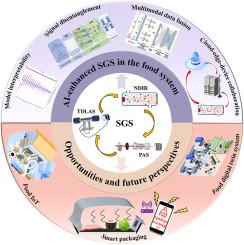AI-empowered spectroscopic gas sensing towards real-time food system monitoring and predictive quality control
IF 15.4
1区 农林科学
Q1 FOOD SCIENCE & TECHNOLOGY
引用次数: 0
Abstract
Background
The advancement of efficient, intelligent, and scalable detection technologies has become a critical priority for ensuring quality control throughout the food supply chain. Spectroscopic gas sensing (SGS) has emerged as a promising analytical approach, offering non-contact operation, rapid response, and high sensitivity. By monitoring changes in ambient gas composition associated with processing, transportation, and storage in food system, SGS techniques enable efficient assessment of food quality and safety.
Scope and approach
This review focuses on promising SGS techniques applied in food system, particularly non-dispersive infrared spectroscopy, tunable diode laser absorption spectroscopy, and photoacoustic spectroscopy. Their fundamental principles, operational parameters, and performance characteristics are systematically reviewed for recent food-related applications. Notably, specific advances in AI-enabled SGS, including signal denoising, feature extraction, multimodal fusion, and dynamic feedback within cloud-edge-device frameworks are addressed. Finally, this review proposes a technical roadmap and conceptual framework for scaling up SGS in food system, highlighting emerging trends in integrating AI-enabled SGS with Internet of Things (IoT), flexible materials, and digital twin systems, and emphasizing the importance of standardized protocols and open spectral datasets for scalable implementation.
Key findings and conclusion
The integration of SGS technologies with advanced AI techniques enables rapid and non-contact detection of food gases at ppm to ppb levels, providing a powerful solution for real-time food system monitoring and predictive quality control. Furthermore, deep interconnection between AI-empowered SGS and IoT networks, intelligent packaging, and digital twin systems, together with the need for unified standards and accessible spectral datasets are crucial future trends.

人工智能支持的光谱气体传感,用于实时食品系统监测和预测质量控制
高效、智能和可扩展的检测技术的进步已经成为确保整个食品供应链质量控制的关键优先事项。光谱气体传感(SGS)已成为一种很有前途的分析方法,具有非接触操作、快速响应和高灵敏度的特点。通过监测食品加工、运输和储存过程中环境气体成分的变化,SGS技术能够有效评估食品质量和安全。本文主要综述了非色散红外光谱、可调谐二极管激光吸收光谱和光声光谱技术在食品系统中的应用前景。它们的基本原理、操作参数和性能特征系统地审查了最近与食品相关的应用。值得注意的是,ai支持的SGS的具体进展,包括信号去噪、特征提取、多模态融合和云边缘设备框架内的动态反馈。最后,本文提出了在食品系统中扩大SGS的技术路线图和概念框架,强调了将人工智能支持的SGS与物联网(IoT)、柔性材料和数字孪生系统集成的新兴趋势,并强调了标准化协议和开放光谱数据集对于可扩展实施的重要性。SGS技术与先进的人工智能技术相结合,可实现ppm至ppb级食品气体的快速非接触检测,为食品系统实时监测和预测性质量控制提供了强大的解决方案。此外,基于人工智能的SGS与物联网网络、智能包装和数字孪生系统之间的深度互联,以及对统一标准和可访问频谱数据集的需求,是至关重要的未来趋势。
本文章由计算机程序翻译,如有差异,请以英文原文为准。
求助全文
约1分钟内获得全文
求助全文
来源期刊

Trends in Food Science & Technology
工程技术-食品科技
CiteScore
32.50
自引率
2.60%
发文量
322
审稿时长
37 days
期刊介绍:
Trends in Food Science & Technology is a prestigious international journal that specializes in peer-reviewed articles covering the latest advancements in technology, food science, and human nutrition. It serves as a bridge between specialized primary journals and general trade magazines, providing readable and scientifically rigorous reviews and commentaries on current research developments and their potential applications in the food industry.
Unlike traditional journals, Trends in Food Science & Technology does not publish original research papers. Instead, it focuses on critical and comprehensive reviews to offer valuable insights for professionals in the field. By bringing together cutting-edge research and industry applications, this journal plays a vital role in disseminating knowledge and facilitating advancements in the food science and technology sector.
 求助内容:
求助内容: 应助结果提醒方式:
应助结果提醒方式:


